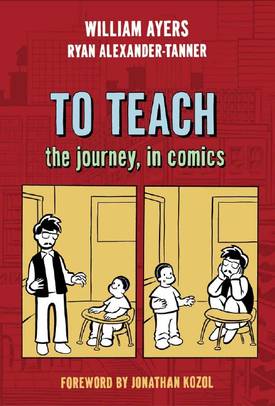
Bill Ayers is perhaps best known as the former Weatherman activist who lived underground with Bernadine Dohrn after a series of bombings and other direct action in the 1970s. But since the 1980s, he has been an educator and professor of education, and has documented this in To Teach: The Journey of a Teacher, now in its third edition.
I haven't read the original To Teach, but I was very pleased to read To Teach: The Journey, in Comics, a graphic adaptation of his memoir/textbook, co-created with illustrator Ryan Alexander-Tanner.
To Teach: The Journey, in Comics is an inspiring educational manifesto that describes, at high level, a method for teaching that is based on letting students lead their education — or rather, embarking on an educational journey with students in which leadership is shared. It's a moving and humanist vision of education, one that flies in the face of contemporary educational practice with its emphasis on technique and standardized evaluation, without much regard for the delight, dignity and curiosity of students.
As I read To Teach: The Journey, in Comics, I found myself recalling my best teachers, and especially their sensitivity and bravery in knowing when to let me pursue my passion (Bev Pannikkar, my grade two teacher, noticed that I was hiding behind the cubbies in her classroom, engrossed in a copy of Alice in Wonderland, and decided to leave me alone for two days until I had read it, the first substantial novel I'd read on my own, and the book that turned me into a reader and then a writer), when to intervene and structure the activity, when to let me progress at my own pace and when to read me the riot act until I challenged myself. These four principles — unstructured self-direction, skilled guidance, structured progress and direct challenging — feel like the essence of good teaching, and knowing when to do what and how is its soul.
While To Teach: The Journey, in Comics is long on inspiring, brief stories and examples of successful educational collaboration, it's short on nitty-gritty details (I get the feeling that these are to be found in the prose To Teach: The Journey of a Teacher). That is, while reading in Comics, I often found myself thinking Yes, that's exactly how you'd do it, and then realizing that I had no idea how you'd apply the lesson I'd just read.
Which is not to say that in Comics isn't worth the read — quite the contrary. If you want a quick shot of inspiration and a forceful argument that learning is best when it is social, engaged, and egalitarian, you will find it here. But to put all this into practice, you will probably need the longer text. Taken together, they make quite a pair.





